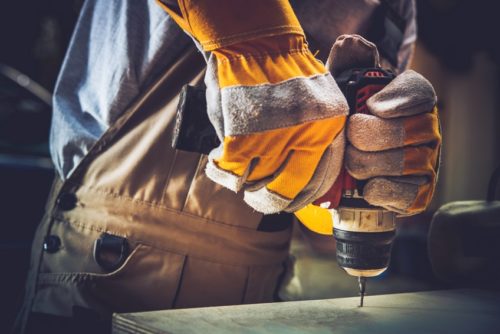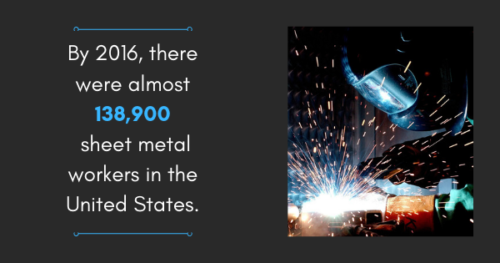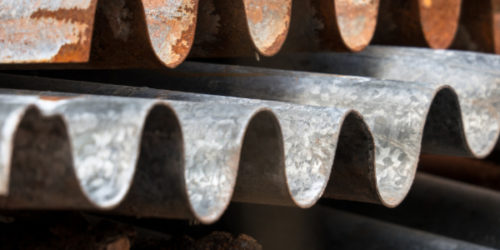5 Types of Sheet Metal Finishes
Leave a CommentMany types of metal are pliable and insulate great. These features make different types of metal extremely useful. But in addition to brass and copper, what is the most versatile of the primary metals? It would have to be the metal made from thin aluminum strips—sheet metal. Here is a look at the thin metal strips of stainless steel sheet metal, a few of the different finishes used on it, and some of the products — or applications — that are made from the different sheet metal varieties.
- Applications of Number One Finish: When stainless steel is heated and then rolled, this creates number one finish. Next step of the process is a heat treatment to make sure that the thin metal strips of stainless steel look uniform and meets all requirements. This type of stainless steel typically has an inconsistent appearance. It is used in items such as furnace linings conveyors, oven liners, kiln liners, and parts for oil burners.
- Applications of Number 2B Finish: Again, stainless steel is rolled, but this time it is cold. This cold rolling process produces a shinier and more reflective finish compared to the completed rolls. This type of stainless steel is used for wheel covers, flatware, laundry, and dry cleaning fixtures, bakeware, and plumbing fixtures, to name a few.
- Applications of Number 2D Finish: The Number 2D finish goes on sheet metal rolls that have been thinned down by cold rolling. The final step in the process is pickling. The applications for this type of stainless steel include furnace parts, rail car parts, roofing, and chemical equipment.
- Applications of Number 3 Finish: Stainless steel sheet metal with a Number 3 finish sets itself apart because it has a pattern pressed into a surface that gives it a look of scratching and abrasion. Additionally, it is fairly bright, offering a modest reflection. The roughness of the Number 3 finish is great for use in kitchen equipment, brewery equipment, and items used in food processing.
- Applications of Number 4 Finish: Picking up where the Number 3 finish left off, the patterning of the Number 4 finish takes it to an even higher level — much brighter and more reflective. For applications with a Number 4 finish, think of luggage carousels, escalator trim, doors on elevators, and hospital surfaces and equipment.
It’s also interesting to note that brass and copper, as well as stainless steel, can be used in various applications. Just imagine a kitchen that is finished with stainless steel; then imagine one that is finished with brass and copper. The two kitchens would have completely different personalities. Working with copper and brass, and even stainless steel sheet-metal can produce a wonderful variety of looks.
And there is an added benefit: metal is recyclable! Right now all around the world, about 40% of all the steel that is produced is created from recycled metal. This is a win for aesthetics and the environment!
A Short Beginner’s Guide to the Benefits of Metal Fabrication
Leave a Comment Metal fabrication pays a big role in the economy. Consider that there were almost 138,900 sheet metal workers in the U.S. in 2016 alone. The metal fabrication industry not only provides jobs to thousands of people but also plays a big role in day to day activities. How? Let’s take a quick look. But first, we need to review some basics about metal fabrication.
Metal fabrication pays a big role in the economy. Consider that there were almost 138,900 sheet metal workers in the U.S. in 2016 alone. The metal fabrication industry not only provides jobs to thousands of people but also plays a big role in day to day activities. How? Let’s take a quick look. But first, we need to review some basics about metal fabrication.
What is Metal Fabrication?
Metal fabrication is the development of thin sheet metal so that it can follow specific shapes. The entire process involves shaping, stamping, folding, cutting, and welding. Sheet metal is normally a quarter of an inch or less, which is important because the metal sheet needs to be pliable so that it can assume different shapes according to the user requirements. Metal fabricators are highly skilled and are trained to manipulate the metal with a surgeon’s precision. When you see a copper sheet metal for sale sign, you should know that the metal has gone through a delicate fabrication process.
Understanding the Fabrication Process
The fabrication process starts with selecting the correct method. Choosing the right method depends on several factors including the thin metal sheet’s intended use, whether it should be a stainless steel sheet metal, and the metals that will make the metal sheet.
Copper sheet metal for sale is popular in the electric industry due to its flexibility and ability to conduct electricity. The sheets are also resistant to corrosion making them ideal for plumping equipment, roofing materials, and shipbuilding.
For instance, if the end product is for shipbuilding, the main metals used are copper and brass. Generally, the fabrication process involves cutting, casting, forging, drilling, turning, and extrusion as the basic process. However, secondary finishing might be required if the part requires to be joined with other metal sheets.
The Importance of Metal Fabrication
Metal has long been known for its properties like structural strength and longevity. Here are some benefits of fabricating metals.
- Increased strength: Metal’s resistance to being pulled apart makes it important for materials like screws and wires. It is tough and has great strength, and at the same time, it is easy to manipulate metal and bend it to any shape.
- Better than plastic: The main competitor to metal is plastic. However, even if the plastic is good in some applications, it cannot be compared to metal. Metal is durable and has a higher resistance to heat compared to plastic.
- Appealing quality: Metal is strong and looks great. This aesthetic quality makes it one of the most sought after building materials all over the world.
- Heat resistance: Metal can withstand a wide range of temperatures. If the fabricator accounted for expansion, it is not likely that heat can destroy a metal part.
- Cost-efficiency: When produced in high volumes, the cost of production is relatively low. Metal fabricating machines are capable of replicating the procedures. Therefore, it is possible to produce many sheets of metal at a low cost per unit.
- Versatility: Metal is capable of withstanding many manufacturing processes such as welding, forging, peening, and many more. Therefore, it is possible to come up with many shapes. No matter which geometrical shape is required, metal is usually the material of choice.
Applications
Fabricated metal is used in many ways. Copper sheet metal for sale can be used in many applications including creating brass or phosphor bronze.
- Motor vehicle industry: Vehicles are made of many materials, but the main material is metal. For instance, the chassis is aluminum, and without metal, vehicles would not have proper structural integrity. About 7% of copper sheet metal for sale is used in the motor industry.
- Tools: Almost everything we use in our daily lives would not exist without metal. Nail drills, vehicles, spades, saws and many more are as a result of metal fabrication.
- Laptop and smartphone shells: Phones and computers are as a result of metal fabrication. The sleek laptop and smartphone cases are made of metal.
- Kitchenware: Almost everything in the kitchen is made of metal.
- Aerospace: Many of aircraft components are made of metal. Designing an aircraft is not a simple task, and one cannot compromise structural integrity. The components must withstand a wide range of temperatures, high pressures, and chemical exposure.
Now that you know a little more about metal fabrication, you just might start seeing more of these things in your day to day life.
Thin Metal Strips: Five Uses for Sheet Metal
Leave a Comment Most of us are familiar with sheet metal. This is metal that has been cut into thin metal strips. It is quite a versatile material because it is a great insulator and very pliable. Here are five industries that make good use of thin metal strips of the versatile material, sheet metal.
Most of us are familiar with sheet metal. This is metal that has been cut into thin metal strips. It is quite a versatile material because it is a great insulator and very pliable. Here are five industries that make good use of thin metal strips of the versatile material, sheet metal.
1. Transportation
Sheet metal is used in the transportation industry in many ways. Primarily, it is used to manufacture car bodies. It is also used to manufacture railroad cars, and airplanes, including metal wings.
2. Architecture
Thin metal strips of sheet metal are fantastic roofing materials. An entire metal roof can be the focal architectural point of a building design. There is a practical aspect to sheet metal as a roofing material, as well. Flashing and rain gutters are often made of sheet metal, as are conductor pipes that serve to direct water away from a building. Combined metals of copper and brass, for example, also add rich aesthetic appeal to a design as well as being efficient and functional. For example, the Chrysler building in New York City is covered in stainless steel sheet metal!
3. Jewelry
Silver, gold, and platinum jewelry often contain thin metal strips, sometimes of combined metals. But what are combined metals? Combined metals are actually an alloy, which is a substance created when metals are combined with other materials that are non-metallic. The result is usually an increase in the hardness and strength of the metal. That is why combined metals are great for jewelry, because using them strengthens the jewelry and preserves the luster of the pieces.
4. Fire Prevention
Thin metal strips which are combined to create pieces of sheet metal are excellent fire retardant materials. Sheet metal is extremely fire resistant. It can be used as an insulator in furnaces and in ductwork. In addition, when used as a wall covering, the sheets can be designed and patterned to resemble brickwork, which increases its aesthetic appeal.
5. Medical Equipment
The strength, durability, and lightweight creations that result from precise sheet metal fabrication make it fantastic for use in the medical field. MRI equipment, operating tables, ultrasound machines, nuclear medicine cabinets, and more are all made from custom sheet metal fabrication. The result is equipment that is reliable and yields results of the highest quality.
There are many more examples of how sheet metal is used in manufacturing and industry, but these five give a good idea of the breadth and scope of the productivity and versatility that sheet metal offers. And because of these factors, it has a huge impact on the economy, too. Currently, $30 billion of revenue is created by the sheet metal industry. With statistics like these, it’s apparent that the sheet metal industry is a very strong and important aspect of American manufacturing and production.

